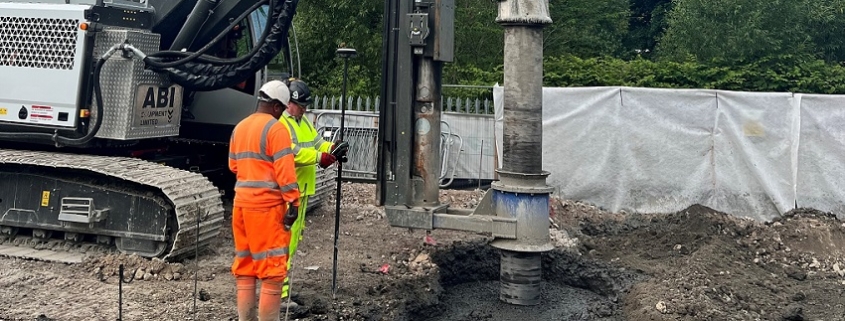What Is Soil Mixing?
Soil mixing is a ground improvement technique that is used to improve the geotechnical qualities of the existing soils or fill material by mixing it with a binder in-situ.
Using binders for various applications we carry out soil mixing of the existing site soils to either produce large diameter stabilised columns, mass mixing for full depth treatment, mass mixing over the top of the columns to provide a transfer mattress, trench mixing to provide cut-off walls or even PRB walls, we do not remove materials from site, this has significant advantages of reducing CO2 emissions, improves sustainability and is recycling on a grand scale.
Soil mixing also reduces project times and costs as well as your carbon footprint on construction projects compared to other more traditional ground engineering methods such as various types of piling, excavate and cart away, dynamic compaction, surcharge etc. You are treating the ground in-situ and will not incur costly excavate and cart away charges.
What Is Soil Mixing Used For?
Soil mixing is used for a range of purposes, making it a highly flexible technology.
Uses include:
- Ground improvement to reduce settlement: factory developments, retail parks, roads, car parks, wind turbines sites, bridge abutments
- Shear stabilisation of embankments: railways, rivers, roads
- Stabilised corridors: for installation of services: sewers, pumping mains, water pipes, gas mains
- Retaining walls: cantilevered, mass fill, and king posts
- Impermeable cut-off walls: flood embankments, canal walls and bases, cofferdams, containment of contaminants within an identified area of pollution
- Permeable reactive barriers (PRB’s): for treatment of contaminated ground water
- Stabilisation of contaminated ground: locking in contaminants in a mass mixed operation
- Vibration control: soil mixed barriers installed to reduce the transfer of irritating vibrations, i.e. railways, industrial factories, construction operations
Depths of up to 35-40m can be reached but generally projects range from 2m to 20m and using some of the latest machines column dimensions of up to 2.4m can be achieved but more commonly 1, 1.5 and 2m are used, meaning the range of uses is vast – from improving the smallest area of soil to greatly increasing the bearing capacity of a lot of land, soil mixing can help.
How Does Soil Mixing Work?
Specially designed tools mechanically mix the soil in-situ with a binder. Depending on the requirements for soil mixing we may use a soil mixing bucket, double rotary mixing head or cutter soil mixer.
Since 2012, we have come up with some remarkable advances in the technology.
We have developed an enhanced double rotary auger system which has twin paddles and these move in opposite directions to enhance the distribution of the materials in the soil mixing process, more so than single auger mixing heads.
This bespoke and superior soil mixing equipment utilises a technique that substantially improves the process of soil mixing with the distribution of the binder vastly improved and mix designs are more finely tuned and accurate. This in turn brings economic benefits to the client.
What Are The Soil Mixing Techniques?
Soil mixing techniques include mass mixing and column mixing. Both offer wet and dry soil mixing solutions and can be used to improve and transform even the most challenging of soil conditions including flood plains and contaminated soil.
Deep Soil Mixing Ltd use the wet mixing method as this is a more environmentally friendly method. The binder is added as a liquid using pumps. The effect is to improve the soil quality, reinforce the soil or to make it less permeable.
In-house binder dosage trials are always carried out to determine the right level, before any work begins, to ensure the right outcome is achieved from the soil mixing project to cut costs and improve effectiveness.
Mass Mixing
Mass mixing is used when the soil is very soft or contaminated and involves using a mixing tool on an excavator to mix the binder into the soil both vertically and horizontally to improve the structural quality of the soil.
Column Mixing
Column mixing involves using the double rotary mixing head or cutter soil mixer and mounted on piling rigs which are then mixed down to the required depth with binder being mixed into the soil as the mixing head goes both down into the soil and comes back up out of the soil. The auger heads rotate at the specified speed as the binder is inserted and mixed to create the required consistency.
Soil mixed columns can be installed individually or overlapping to improve the load capacity of the ground.
What Are The Benefits Of Soil Mixing?
So why consider soil mixing for your projects over other more traditional ground remediation methods:
- Reduces construction programme
- No need to excavate and cart away so reducing landfill tax charges
- Zero vibration during construction
- Minimal spoil removal
- Wide range of soils can be treated compared to other solutions
- Soil can be used as construction material
- No need to bring costly and bulky materials on site
- Environmental – Reduction of Carbon Footprint
- Effective on different soils, including soft soils, flood plains, contaminated land, peat, silts and alluvium etc.
- Increases bearing pressure, controls settlement and reduces permeability






